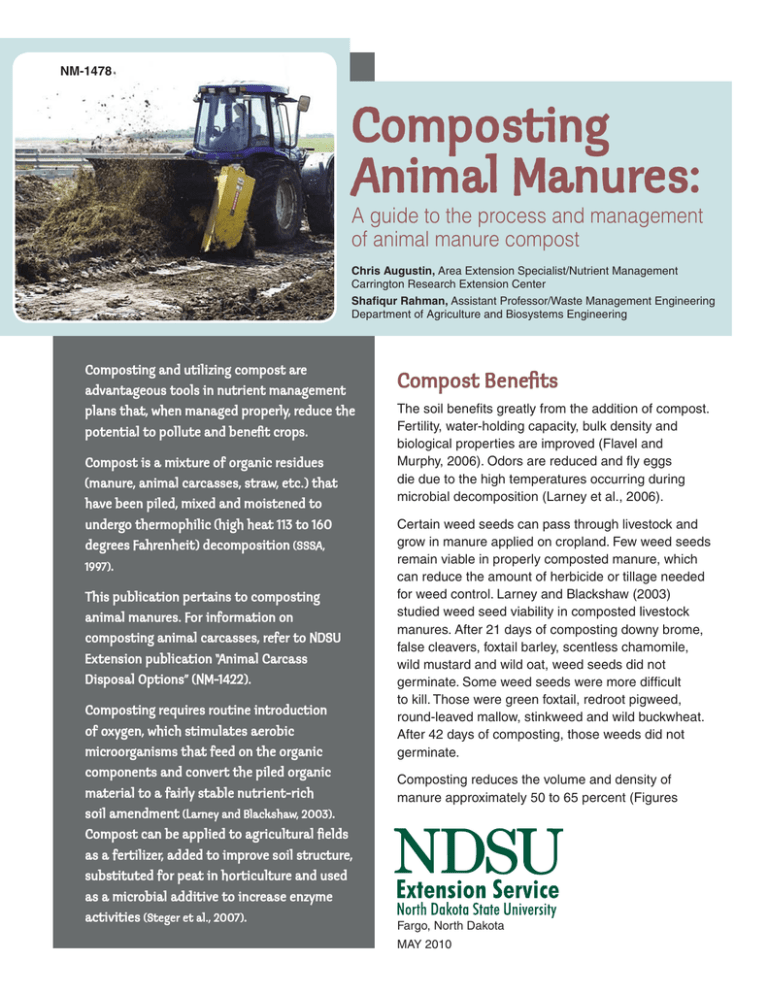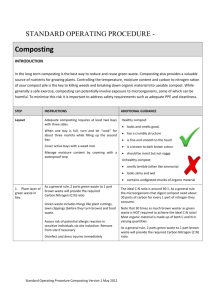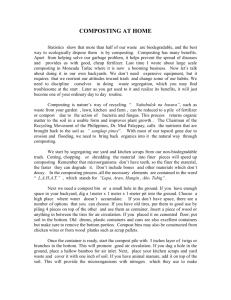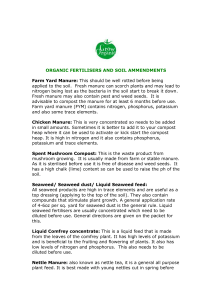Composting Animal Manures: Compost Benefi ts
advertisement

NM-1478 Composting Animal Manures: A guide to the process and management of animal manure compost Chris Augustin, Area Extension Specialist/Nutrient Management Carrington Research Extension Center Shafiqur Rahman, Assistant Professor/Waste Management Engineering Department of Agriculture and Biosystems Engineering Composting and utilizing compost are advantageous tools in nutrient management plans that, when managed properly, reduce the potential to pollute and benefit crops. Compost is a mixture of organic residues (manure, animal carcasses, straw, etc.) that have been piled, mixed and moistened to undergo thermophilic (high heat 113 to 160 degrees Fahrenheit) decomposition (SSSA, 1997). This publication pertains to composting animal manures. For information on composting animal carcasses, refer to NDSU Extension publication “Animal Carcass Disposal Options” (NM-1422). Composting requires routine introduction of oxygen, which stimulates aerobic microorganisms that feed on the organic components and convert the piled organic material to a fairly stable nutrient-rich soil amendment (Larney and Blackshaw, 2003). Compost can be applied to agricultural fields as a fertilizer, added to improve soil structure, substituted for peat in horticulture and used as a microbial additive to increase enzyme activities (Steger et al., 2007). Compost Benefits The soil benefits greatly from the addition of compost. Fertility, water-holding capacity, bulk density and biological properties are improved (Flavel and Murphy, 2006). Odors are reduced and fly eggs die due to the high temperatures occurring during microbial decomposition (Larney et al., 2006). Certain weed seeds can pass through livestock and grow in manure applied on cropland. Few weed seeds remain viable in properly composted manure, which can reduce the amount of herbicide or tillage needed for weed control. Larney and Blackshaw (2003) studied weed seed viability in composted livestock manures. After 21 days of composting downy brome, false cleavers, foxtail barley, scentless chamomile, wild mustard and wild oat, weed seeds did not germinate. Some weed seeds were more difficult to kill. Those were green foxtail, redroot pigweed, round-leaved mallow, stinkweed and wild buckwheat. After 42 days of composting, those weeds did not germinate. Composting reduces the volume and density of manure approximately 50 to 65 percent (Figures Fargo, North Dakota MAY 2010 Figure 1. Initial windrows of bedded feedlot manure. The west pile cannot be seen in this picture and note the initial height of the middle pile. Figure 2. Composted bedded feedlot manure. The west pile can be seen and the final height of the middle pile is greatly reduced. Composting animal manures is an effective way to kill pathogens. Grewal (2006) studied and compared the length of time that pathogens lived in simulated composted dairy manure, a simulated dairy manure pack and a simulated liquid dairy lagoon. Grewal found that after three days of composting at 131 F, Escherichia coli, Salmonella and Listeria monocytogenes were not detected. However, Salmonella still was detected after 28 days in the manure pack and lagoon simulations. Escherichia coli and Listeria monocytogenes were found in the lagoon after 14 days, and Listeria was not found after seven days in the bedded pack simulations. 1 and 2). The decrease in volume reduces hauling costs. Wiederholt et al., (2009) conducted a case study that compared the energy required of a 180head feedlot operation that applied raw manure and composted manure to agricultural fields. They concluded that composting and applying livestock compost is more energy efficient than hauling raw manure. The decrease in volume and mass from composting reduced the hauling requirements enough to offset the energy required to compost. The energy ratio of raw manure to composted manure was 1.56-to-1 energy units. 2 Site Selection Composting should take place on an area that drains well but where runoff or leachate will not reach waters of the state. The pad ideally should drain into a containment pond. The site may not be located along surface waters of the state, on soil textures coarser than a sandy loam or within a flood plain. Ideal areas are well-drained, have slopes of 2 to 4 percent, consist of concrete or packed soil or gravel and drain into a containment pond. Windrows should be constructed parallel to the slope. This prevents the windrow from blocking runoff and allows implement access to the pad. Slopes exceeding 6 percent may be prone to erosion and can cause pad issues. The C/N ratio in a composting pile needs to range from 20-to-1 (20 parts of carbon for every part of nitrogen) to 40-to-1 (40 parts of carbon for every part of nitrogen). Decomposing microorganisms typically have a C/N ratio of 5-to-1 to 10-to-1. The C/N ratio needs to be higher because approximately 50 percent of the metabolized carbon is released as carbon dioxide (Miller, 1996). Nitrogen can be lost when too much (C/N ratio below 20-to-1) is present, and the pile might smell of volatizing ammonia. Adding carbon (straw or woodchips) can help alleviate this. Too much carbon (C/N ratio more than 40-to-1) in a compost pile can immobilize nitrogen and slows the composting process (Coyne and Thompson, 2006). Composting material’s C/N ratio varies greatly. Differences in manure can be from species, feeding rations, climate, storage facility, etc. The C/N ratio of bulking materials of plant origin varies greatly as well and for the same reasons as manures. Table 1 outlines many of the properties that various composting materials possess. Figure 4 and Table 2 illustrate the process of determining the C/N ratio. Composting Manure Process The microorganisms responsible for composting are indigenous to manures. By properly managing compost, the producer facilitates these decomposing microbes. The manure must be piled, the carbon-tonitrogen (C/N) ratio should be 30-to-1, 50 percent of the pore space should contain water and the pile must be aerobic (having oxygen) (Rynk et al., 1992). Water management is important in compost because 40 to 65 percent of the pore space in composting materials should have water. Measuring devices can be used to monitor the moisture, but they can be costly. Manure usually is piled into a windrow. The pile commonly is 10 to 12 feet wide and 4 to 6 feet high (Figure 1). The windrow dimensions are dictated by the length of the pad and size of the turning implement. After a day or two, the pile should reach temperatures in excess of 120 F (Figures 3 and 6). One way to test moisture is the simple hand test called the “wet rag test.” Squeeze the compost and Figure 3. Average temperatures of a strawbedded beef feedlot manure compost pile. The manure was piled into windrows on May 8. The pile was turned on May 30, June 13, June 23 and July 29. The pile did not pass the wet-rag test on June 11 and was watered the same day. This pile may be piled for curing after Aug. 4. 3 Table 1. Carbon-to-nitrogen (C/N) ratio of common composting materials. feel for moisture. If water drips out, then it is too wet. But if the compost feels like a wrung-out wet rag, the compost has sufficient amounts of moisture (Rynk et al., 1992). Remember to wash your hands after working with compost. Moisture usually is not an issue in central and eastern North Dakota. However, water may have to be added in western North Dakota or during prolonged dry events. Some turners have water tanks plumbed into nozzles that add water while turning. Water also may be added by spraying it directly on the pile (Figure 5). The microorganisms that transform manure into compost require oxygen for their energy-deriving chemical reactions. Less than 5 percent of oxygen within the pore space will turn the pile anaerobic (without oxygen), may create a rotten-egg smell and will slow the composting process. Aerobic conditions can be replenished by turning the pile (Rynk et al., 1992). Material C/N Ratio Material C/N Ratio Cattle Manure Cattle Carcass Corn Silage Corn Stalk Dairy Manure Grass Clippings Horse Manure Leaves 19:1 10:1 40:1 68:1 20:1 17:1 30:1 54:1 Poultry Carcass Sawdust Sheep Manure Swine Carcass Swine Manure Turkey Litter Wheat Straw Wood Chips 4:1 442:1 16:1 14:1 12:1 16:1 127:1 600:1 (Rynk et al., 1992) Figure 4. An example of using the Pearson Square method for proper compost mixture determination. Pearson Square Procedure: 1 is the C/N ratio of a typical straw. 2 is the C/N ratio of typical beef manure. 3 is the difference of straw and beef manure. 4 is the desired C/N ratio. 5 is the difference of beef manure C:N ratio and desired C:N ratio. Multiplying this value by 100 reveals that 16.67% of straw is needed for the desired C/N ratio. 6 is the difference of straw C/N ratio and desired C/N ratio. Multiplying this value by 100 reveals that 83.33% of manure is needed for the desired C/N ratio. Figure 5. Watering compost at the Carrington Research Extension Center during an extremely dry period. 4 Table 2. A worksheet to determine C/N ratio mixture of composting materials. E M q i u Adjusted n Desired a C/N Ratio Materials C/N u C/N l (Absolute C/N Ratio Material Ratio s Ratio s Value) Difference E E D q q i u u Adjusted v a a C/N Ratio i l Dividing l (Absolute d Dividing s Factor* s Value) e Factor* Swine Manure 12:1 – 30:1 = 18 127–12 = 115 = 18 ÷ 115 = 0.157 X 100 = 15.7% 84.3% – 100% = Swine Manure Wheat Straw 127:1 – 30:1 = 97 127–12 = 115 = 97 ÷ 115 = 0.843 X 100 = 84.3% 15.7% – 100% = Wheat Straw Equals RecomMultiply mended by 100 Co-product Equals (%) Minus 100% Equals – = = = ÷ = X 100 = – 100% = – = = = ÷ = X 100 = – 100% = – = = = ÷ = X 100 = – 100% = – = = = ÷ = X 100 = – 100% = – = = = ÷ = X 100 = – 100% = – = = = ÷ = X 100 = – 100% = Recommended Mixture (%) *Dividing Factor is the difference of C/N ratios of different composting materials. The value used is the absolute value. Monitoring the pile temperature with a probe-type thermometer can indicate when to turn the pile (Figure 6). To efficiently compost manure, turn the pile when temperatures drop below 110 F. After three to five turns, the manure should be composted. Temperatures should be taken at various locations and depths. According to Michel (2009), compost windrows can be turned every 10 days or two weeks. This can minimize labor while creating a good-quality product. Organic Program requires pile temperatures to exceed 131 F for 15 days and piles to be turned at least five times (The Organic Center, 2006). Piles may exceed 160 F, which can destroy the beneficial microbes, causing a decline in microbial activity and slowing the process. If this occurs, chances are the piles have too much nitrogen. Adding carbon, making the piles smaller and digging holes in the pile are ways of cooling the pile (CarpenterBoggs, 1999). Organic operations must meet certain temperature and turning frequency requirements. The National Compost Aeration Methods Turning manure is essential to composting manure. Turning compost incorporates oxygen into the system, homogenizes the pile and breaks up clumps. Mixing allows more contact of manure with microbes. Producers have various ways to turn the pile. The two Figure 6. Twenty-four hours after raw strawbedded feedlot manure was piled in early May, temperatures already have reached 132 F. 5 Turning becomes easier throughout the composting process. Some front-mount turners clean pens and windrow the manure in the same pass. The benefit of this is that space and time are saved by eliminating the external pad and not hauling the manure out of the pen. most common methods for turning compost are with a windrow turner (Figures 7 and 8) or bucket tractor. Turners may be self-propelled or attached to a tractor or skid steer. Turners mix the compost by an auger, rotary drum with flails or an elevating conveyor. Some turners require power from the attached implement, while others are self-powered. Other ways to incorporate oxygen include using passively aerated windrows and aerated static piles. Passively aerated windrow systems require peat moss, wood chips or some type of material to be added to increase porosity. Perforated pipes are placed within the pile to allow airflow. No mechanical mixing is required, but the windrow should be constructed above 6 to 12 inches of compost or peat moss and covered by a layer of compost or peat moss. This covering insulates the pile and absorbs excess moisture. An aerated static compost pile is similar to passively aerated windrows but has fans that force air through the perforated pipes. (Rynk et al., 1992). Producers have many factors to consider when selecting a turner. Determining the amount of manure to turn is a good starting point. Bucket tractors or skid steers work well for small operations or testing if compost fits into your operation. However, turner implements work better for larger operations. Turners range in various sizes from 6 feet wide to as much as 20 feet wide. A 10-foot-wide turner may turn 1,500 yards per hour, while a 14-foot turner may turn as much as 2,600 yards per hour. Implements that run a turner must have a creeper gear and go as slowly as 20 feet per minute. Figure 7. Front-mount composter. This compost turner cleans pens, windrows and turns the pile in the same pass. Figure 8. A pull-type compost turner that is turning windrowed bedded feedlot manure for the first time. 6 Crop and environmental benefits may not occur if the finished composted product is not tested and properly applied. Once cured, compost samples should be taken within the pile at various points and mixed thoroughly to account for variability. Samples should be tested as soon as possible or kept in cold storage until they can be sent to a laboratory for analysis. Refer to NDSU Extension publication “Manure Sampling for Nutrient Management Planning” (NM1259) for more sampling methods and interpretation of test results. After the heating cycles have subsided, compost usually is piled for storage while awaiting field applications. This month long or longer process is known as curing. Applying immature compost can cause issues that include malodors, insect swarms, nitrogen immobilization and phytotoxicity (Mathur et al., 1993; Francou et al, 2005; Steger et al., 2007). Compost maturity is strongly related to microbial activities during the composting process. Producers have many options to assess compost maturity. Options include sending samples to laboratories, checking pile temperatures to ensure that the pile is near the ambient temperature (Figure 3) and kits that give colormetric readings of carbon dioxide and ammonia emissions. Nutrient Management of Compost Manure composts not only improve soil physical and chemical characteristics; they also are a good source of fertilizer for crop production. However, much of the nitrogen is tied up in complex organic compounds (immobilized) and is not immediately ready for plant uptake, whereas commercial fertilizers are predominantly plant-available. Cropland soils and compost should be tested for nutrients. Nitrogen, phosphorus and potassium tend to be the most limiting nutrients required by crops (Coyne and Thompson, 2006). Applications of compost must be based on crop needs. Manure applications usually are based on nitrogen needs for that crop (North Dakota Department of Health, 2005). Most crops have a nitrogren-to-phosphorus (N/P) ratio of 7-to-1 to 10-to-1, whereas composted manure commonly has an N/P ratio of 1-to-2. Because of this, nutrient management plans may need to be based upon phosphorus management. This change in management can prevent nutrient loading and high levels of phosphorus that can accumulate when not properly managed and monitored (Spargo et al., 2006). Sampling and testing soil for nutrients can alleviate nutrient loading. Refer to NDSU Extension publications “North Dakota Fertilizer Recommendation Tables and Equations” (SF882) and “Soil Sampling as a Basis for Fertilizer Application” (SF-990) for more information on soil sampling and nutrient requirements. Keep in mind that many testing labs treat compost nutrient availability as if it were raw manure (approximately 50 percent nitrogen, 80 percent phosphorus and 90 percent potassium of the total nutrients are plant-available the first growing season). Compost nutrient availability is different and producers need to account for the differences. This difference is due to the increased stability of compost. Eghball and Power (1999) found in a four-year study that 15 percent of the total nitrogen in beef feedlot compost was plant-available the first year and 8 percent of the nitrogen was mineralized the second year. Wen et al. (1997) found in a two-year study that 30 percent and 70 percent of the total phosphorus in composted livestock manure was mineralized the first and second year, respectively. A greenhouse study conducted by Bar-Tall et al. (2004) showed that 31 percent of the total potassium in compost is mineralized. Because of immobilization and the possibility of nutrient loading, compost fertilizer applications may need to be supplemented with conventional fertilizers. Eghball and Power (1999) tested different management strategies (compost applications based on nitrogen or phosphorus and conventional fertilizer). They found that managing composts based on phosphorus and supplementing the other nutrient requirements with conventional fertilizers yielded equal or greater corn yields. Compost should be applied with a calibrated spreader. This ensures that the proper amount of nutrients is applied and also lessens the chance of polluting. Manure spreaders can be calibrated various ways. Refer to NDSU Extension publication “Manure Spreader Calibration for Nutrient Management Planning” (NM-1418) for spreader calibration procedures. 7 Summary Manure needs to be managed properly to be composted properly. Carbon/nitrogen ratios should be about 30-to-1, moisture content should be around 50 percent and air needs to be incorporated routinely by turning. This ensures that the pile will heat and convert to compost effectively. Surface and ground water proximity are important for compost site selection. The compost site needs to be in an area not prone to contamination of groundwater by leaching or where leachate can run off to surface water. Instead of viewing manure as a waste, producers can begin to view it as a product that can be substituted for commercial fertilizer and as an economic resource Composting is an effective manure management tool that reduces volume, kills pathogens and weed seeds, and also improves soil health and fertility. However, soil and compost should be tested for nutrients. Applying compost with a calibrated spreader ensures that crop yield goals will be met and reduces the chance of pollution. The volume reduction of composting manure can save producers money. The NDSU Extension Service does not endorse commercial products or companies even though reference may be made to tradenames, trademarks or service names. This publication may be copied for noncommercial, educational purposes in its entirety with no changes. Requests to use any portion of the document (including text, graphics or photos) should be sent to NDSU.permission@ndsu.edu. Include exactly what is requested for use and how it will be used. For more information on this and other topics, see: www.ag.ndsu.edu County commissions, North Dakota State University and U.S. Department of Agriculture cooperating. North Dakota State University does not discriminate on the basis of race, color, national origin, religion, sex, gender identity, disability, age, status as a U.S. veteran, sexual orientation, marital status, or public assistance status. Direct inquiries to the Vice President for Equity, Diversity and Global Outreach, 205 Old Main, (701) 231-7708. This publication will be made available in alternative formats for people with disabilities upon request, (701) 231-7881. 1M-5-10 References Bar-Tal, A., U. Yermiyahu, J. Beraud, M. Keinan, R. Rosenbery, D. Zohar, V. Rosen and P. Fine. 2004. Nitrogen, phosphorus, and potassium uptake by wheat and their distribution in soil following successive, annual compost applications. J. Environ. Qual. 33:1855 1865. Carpenter-Boggs, L. 1999. Composting animal mortality resource notebook. Minnesota Agricultural Experimental Station Miscellaneous Publication 100-1999. Morris, Minn. Coyne, M.S., and J.A. Thompson. 2006. Math for soil scientists. pg. 176-190 and 199-208. Thomson Delmar Learning, Clifton Park, N.Y. Eghball, B. 2000. Nitrogen mineralization from field-applied beef cattle feedlot manure or compost. Soil Sci. Soc. Am. J. 64:2024-2030. Eghball, B., and J.F. Power. 1999. Phosphorus- and nitrogen-based manure and compost applications: corn production and soil phosphorus. Soil Sci. Soc. Am. J. 63:895-901. Flavel, T.C., and D.V. Murphy. 2006. Carbon and nitrogen mineralization rates after application of organic amendments to soil. J. Environ. Qual. 35:183-193. Grewal, S.K., S. Rajeev, S. Sreevatsan and F.C. Micheal Jr. 2006. Persistance of Mycobacterium avium subsp. Paratuberculosis and other zoonotic pathogens during simulated composting, manure packing, and liquid storage of dairy manure. Larney, F.J., and R.E. Blackshaw. 2003. Weed seed viability in composted beef cattle feedlot manure. J. Environ. Qual. 32:1105-1113. Larney, F.J., K.E. Buckley, X. Hao and W.P. McCaughey. 2006. Fresh, stockpiled, and composted beef cattle feedlot manure: nutrient levels and mass balance estimates in Alberta and Manitoba. J. Environ. Qual. 35:1844-1854. Michel, F.C. Jr. 2009. On farm-scale composting. Midwest manure summit, Green Bay, Wis. March 24-25, 2009. Miiler, R.M. 1996. Biological processes affecting contaminant fate and transport. In Pollution Science. pg. 77-91. I.L. Pepper, C.P. Gerba, and M.L. Bruddeau (eds). Academic Press, San Diego, Calif. North Dakota Department of Health. 2005. North Dakota Livestock Program Design Manual. North Dakota Department of Health Environmental Health Section Division of Water Quality. www.ndhealth. gov/WQ/AnimalFeedingOperations/Final%20Rules/Design%20Manual. pdf. Rynk, R., M. van de Kamp, G.B. Willson, M.E. Singley, T.L. Richard, J.J. Kolega, F.R. Gouin, L. Laliberty Jr., D. Kay, D.W. Murphy, H.A.J. Hoitink and W.F. Brinton. 1992. On-Farm composting handbook. (ed). R. Rynk. p. 6-13, 106-113. Northeast Regional Agricultural Engineering Service, Ithaca, N.Y. Spargo, J.T., G.K. Evanylo and M.M. Alley. 2006. Repeated compost application effects on phosphorus runoff in the Virginia Piedmont. J. Environ. Qual. 35:2342-2351. Soil Science Society of America. 1997. Glossary of Soil Science Terms. p. 22. Soil Sci. Soc. Am., Madison, Wis. The Organic Center. 2006. E. coli 0157:H7 frequently asked questions. Critical issue report 2006.3. www.organic-center.org/reportfiles/e_coli_ final.pdf. Verified Nov.24, 2009 Wen, G., T.E. Bates, R.P. Voroney, J.P. Winter and M.P. Schellenbert. 1997. Comparison of phosphorus availability with application of sewage sludge, sludge compost, and manure compost. Commun. Soil Sci. Plant Anal. 28(17&18):1481-1497. Wiederholt, R.J., S. Rahman and A. Ehni. 2009. Energy efficiency of composting: A case study. In GIS applications in agriculture – nutrient management for improved energy efficiency. CRC Press (in review). Wortmann, C.C., M. Helmers, A. Mallarino, C. Barden, D. Devlin, G. Pierzynski, J. Lory, R. Massey, J. Holz, C. Shapiro and J. Kovar. 2005. Agricultural phosphorus management and water quality protection in the Midwest. University of Nebraska-Lincoln Extension, Lincoln, Neb. www.ianrpubs.unl.edu/epublic/live/rp187/build/rp187.pdf.







